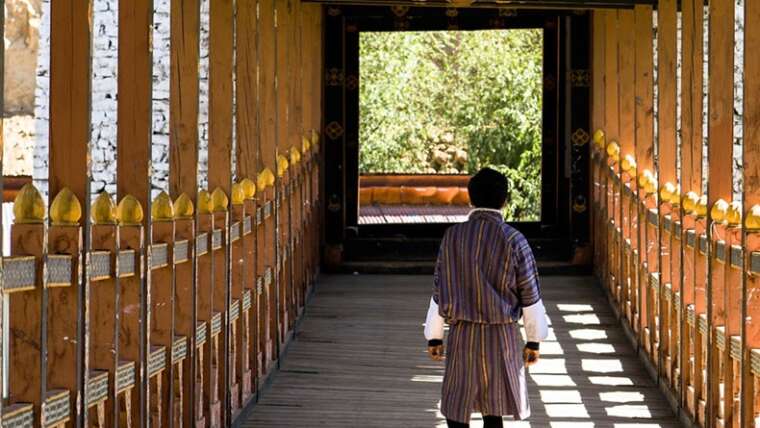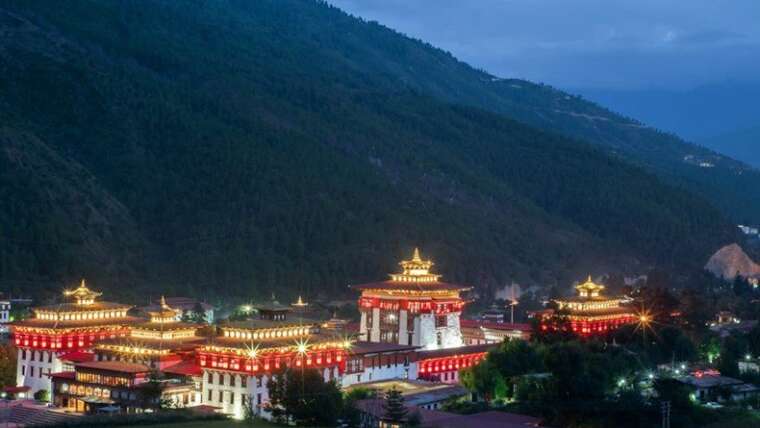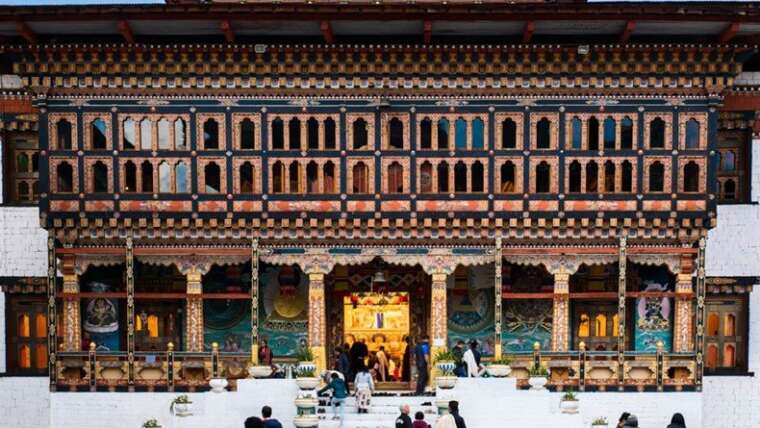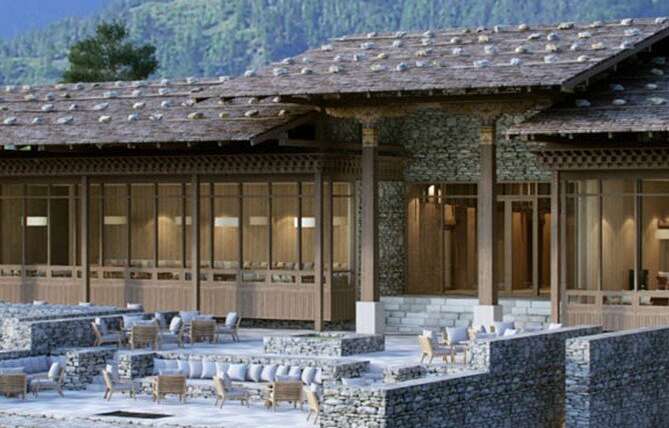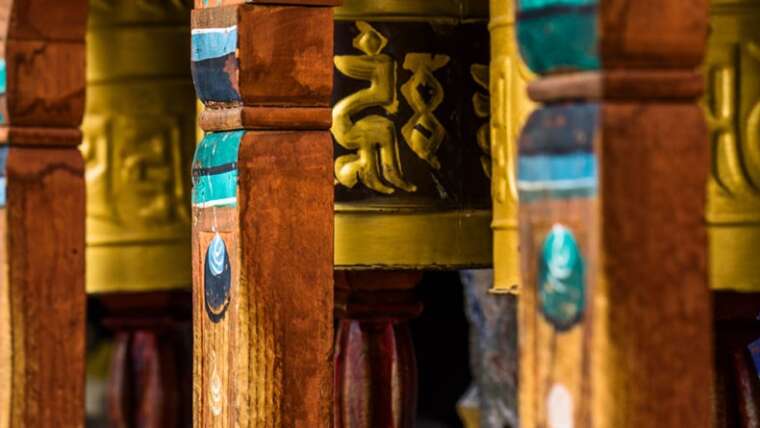Travel back in time and take a journey that few people have had the opportunity to experience. Druk Yul, Bhutan’s official name, is known as the Land of the Dragon People with a rich cultural heritage that has largely remained hidden until its recent emergence onto the world stage. Your guide will meet you upon arrival and accompany you on your khamsa ‘royal stroll’ through the Kingdom, sharing insights to the culture, history and local life of each valley as you go.
Discover the country’s breathtaking natural beauty, meet and mingle with our Bhutanese friends as you embrace the philosophy of a nation that is guided by the principles of ‘Gross National Happiness’. Our khamsas are designed with just the right balance of meaningful encounters and experiences in mind along with a healthy dose of fun.
Day 01: Paro – Thimphu
After arriving at Paro International Airport, your journey begins with a one-hour drive, passing rich, forested mountains dotted with monasteries and temples on route to Thimphu, the capital.
At an altitude of 7,700 feet (2,200 meters), Thimphu lies in a steep valley and is the only capital city in the world without a single traffic light.
Six Senses Thimphu, our “Palace in the Sky’ is situated high above the valley floor, overlooking apple orchards and young pine forests. With captivating views over the world’s tallest seated Buddha, the location provides a perfect escape from the capital and yet is close enough to explore its many attractions.
We recommend slower paced activities on your first day as you adjust to the altitude. If energy levels allow, head down the valley to the town and wander with your GUIDE through Thimphu’s lively streets and markets. Stop in at Zorig Chusum (The National Institute of 13 Arts and Crafts) to discover Bhutan’s numerous art forms before crossing the road to visit the Folk Heritage Museum, which offers insights into Bhutanese daily life of the past.
Don’t miss a visit to the Tashi Chho Dzong, Thimphu’s impressive Buddhist monastery and fortress, which presently houses the throne room and offices of His Majesty, the King of Bhutan, as well as the head of the country’s religious order.
Return to the lodge and test your strength and skills with archery, Bhutan’s colorful national sport. Don’t forget to adopt the local custom of singing, dancing and distracting your opponent to gain the upper hand. Then ease your tired muscles with a Dotsho (Bhutanese hot stone bath with herbs) in the spa followed by a jet lag massage before dinner at signature restaurant Namkha, which offers views over the lodge’s reflecting ponds to the sparkling lights of the valley below. Settle into the comfort of your suite or villa for a well-deserved night’s rest.
Day 02: Thimphu
Rise to the Thimphu morning with an optional yoga or meditation class before heading out across the valley to visit the majestic Buddha Dordenma statue (170 feet/52 meters), perched high above the capital.
From here an optional two-hour hike takes you to Changangkha Lhakhang, one of the oldest monasteries in Thimphu, with sweeping views across the valley. (The monastery can also be accessed by car for those who choose not to hike).
Next look into the future at Pangri Zampa Lhakhang, a 16th-century monastic school of astrology where you can see what the stars have in store for you with a reading by one of the resident monks (by prior arrangement). From there it’s only a short distance to the Royal Textile Museum, which showcases the intricate art of Bhutanese weaving.
Afterwards create your own stamp at the National Post Office before returning home for a Bhutanese afternoon tea at Lunsigang, our picnic spot high above the lodge with views to the surrounding peaks.
Day 03: Thimphu – Punakha
Six Senses Thimphu to Six Senses Punakha “Flying Farmhouse Amidst Rice Fields”
Today’s journey takes you towards Punakha over the iconic Dochula Pass. On a clear, sunny day, you’ll enjoy dramatic views of the Himalayan peaks as you ascend towards the pass. At a height of 10,000 feet (3,050 meters), there are striking cloud-capped valley views and 108 hillside chortens (Buddhist shrines).
Your guide will find a tranquil spot to enjoy a picnic surrounded by nature on the way. Continuing your adventure, descend into beautiful Punakha Valley.
Owing to its lower altitude (4,265 feet/1,300 meters), Punakha offers a warmer climate and is the preferred winter destination for many Bhutanese. Mark your arrival in the valley by spinning a prayer wheel for good luck before crossing over a dramatic suspension bridge hung with colorful Buddhist prayer flags. Stop mid-way for a meditative moment and take in the sound of the rushing river far below.
From the bridge you can opt to indulge in late afternoon cocktails riverside in a rice field. Whether you prefer yours shaken or stirred, you’ll want to toast your arrival to this beautiful valley with pomegranate martinis served up with views to the impressive Punakha Dzong. Watch the sun set and snack on local delicacies like fresh spring rolls and dzao, (popped Bhutanese rice).
Afterwards, it’s a short 20-minute drive through lush scenery as you ascend to the Six Senses lodge.
Check in at Six Senses Punakha’s cozy ‘Flying Farmhouse’, a cantilevered wooden structure that serves as a lounge with gorgeous views over the lodge’s heated swimming pool and terraced rice fields below.
Treat tired muscles with your choice of a deeply-relaxing, 60-minute massage at the spa. We recommend the Marma Massage, which uses long and firm flowing movements of varying pressure to eliminate stress-related tension and to balance and align vital energy centers. Enriching oils with powerful active benefits are applied to balance the heart chakra and enhance one’s overall sense of well-being.
Day 04: Punakha
Six Senses Punakha “Flying Farmhouse Amidst the Rice Fields”
This morning begins with a hike through terraced rice fields as you ascend towards Chorten Ningpo, a monastery which dates to the 17th century. (2.5 hr. moderate hike). Visit Kabasa village on the way with its school, monastery and typical Bhutanese farmhouses.
Continue to climb towards Chorten Ningpo where in addition to the dramatic views, you can discover a statue of Maitreya, the future Buddha, with images trailing the lineage of the great lamas (gurus). Your guide will recount for you the legend of the blazing log thrown by the “Divine Madman”.
Reward yourself with a steaming cup of chai served in an open sala. If the timing is right, you may come across a blessing ritual in progress and experience the otherworldly sounds of monks chanting in unison accompanied by the rhythmic beating of drums and trumpeting horns.
On the way back to the lodge stop off to visit the home of Aum Tshewang and sample her homemade ara (Bhutanese moonshine). We suggest no more than two shots! Lunch today is a delicious Bhutanese Thali set served outdoors on the patio at the lodge. If you have never tried emi datshi, Bhutan’s incendiary national dish of chilis and cheese, now is your chance!
This afternoon, explore the beautiful Punakha Dzong, known officially as Pungtang Dechen Phodrang Dzong, or “The Palace of Great Happiness.” Located at the junction of the Pho Chuu (father) and Mo Chuu (mother) rivers in the Punakha-Wangdue Valley, the dzong’s majestic structure stands six stories high. Bhutan’s second oldest dzong, it served as the seat of the Kingdom’s government until the time of the second King and today is the winter home of the Je Khempo, head abbot of Bhutan, along with a retinue of about 1,000 monks.
Afterwards you can choose to bicycle or try white water rafting along the river next to the dzong or relax back at the lodge. This evening, our chefs will prepare a delicious Indian menu at Ari, the lodge’s signature restaurant, or you can opt for a poolside barbecue.
Day 05: Punakha
Six Senses Punakha “Flying Farmhouse Amidst the Rice Fields”
Start your day with a bicycle ride along the river valley discovering the natural beauty of Punakha. A special picnic lunch is arranged for you on the riverside as you rest. After your meal, enjoy the ride to Talo Nobgang Village and visit Dorji Lhuendrup Nunnery, a meditation center for nuns and Nobgang Monastery, the former residence of a famous Tibetan lama. Talo is also the birthplace of the Kingdom’s four Queen Mothers.
Continue the afternoon with a visit to Chimi Lhakhang, a fertility temple built in 1499 and dedicated to the “Divine Madman” Drukpa Kunley, a brilliant but philandering 14th century monk with a penchant for wine and women. This walk is renowned as a pilgrimage for couples planning to start a family and hoping to receive a blessing from the saint. The adjacent village has some of the most surprisingly graphic phallus paintings in honor of the saint on its homes and shops.
Return to the lodge for an optional afternoon yoga session or perhaps rejuvenate with a relaxing footbath at the spa. Continue to unwind with gorgeous view of Punakha Valley from the “Flying Farmhouse” Living Room before having dinner at your convenience.
Day 06: Punakha – Gangtey
Six Senses Punakha “Flying Farmhouse Amidst the Rice Fields” to Six Senses Gangtey “Traditional Birdwatching Bridge”
Transiting from Punakha to Gangtey, your route follows through the bamboo and oak forests of Nobding Valley, eventually leading you to Lawa la Pass. As you climb upwards keep an eye out for the yak that graze along the route. Continue to drive towards Phobjikha Valley, which is situated at 9,500 feet (2,900 meters) and proceed directly to Six Senses Gangtey to check in and enjoy a tasty lunch while reveling in the views from our lodge which draw the eye across the wetlands sprinkled with tiny goembas and lhakhangs (monasteries and temples).
After lunch, take a walk down to the Black-necked Crane Visitor Centre directly below the lodge, a conservation center dedicated to protecting Thrung Trung Karmo, as these vulnerable birds are known in the Kingdom. The valley is the winter residence for approximately 400 cranes who migrate here from Tibet each year between the months of October and March. Phobjikha is a designated conservation area supported by the Bhutanese government with assistance from the World Wildlife Fund. The lack of powerlines here will impress photographers and conservationists alike. The government had them buried underground several years ago to protect this precious habitat of the cranes.
Afterwards, go walking or mountain biking or relax in the lodge and indulge in a nourishing Swedana steam treatment designed for rejuvenating and cleansing your body, mind and soul (optional) before sitting outdoors and enjoying refreshments by the fire pit as the setting sun illuminates the valley with golden rays.
This evening enjoy dinner at Baa Zam, Six Senses Gangtey’s signature restaurant situated in the lodge’s “Birdwatching Bridge” with floor to ceiling windows that offer expansive views over the valley.
Day 07: Gangtey
Six Senses Gangtey “Traditional Birdwatching Bridge”
This morning head out for one of the Kingdom’s classic hikes, the Loma Longtey trail, which begins at Pele La Pass and winds through a small village where the yak herders put up their camps during winter. Continue through thick dwarf bamboo toward a rhododendron forest.
While hiking, observe local farmers performing their daily routines. The trail carries you up to Kayche La Pass at 12,140 feet (3,700 meters), where stunning views of Phobjikha Valley and Gangtey Village await.
Return to the lodge for a late lunch and a bit of rest before a short drive into Gangtey Village to explore the quaint shops of this one-street town and visit the the 16th century golden-topped Gangtey Goemba (monastery) at the head of the valley which encompasses a school, meditation facilities and quarters for monks, and is home to the mind reincarnation of Pema Lingpa, one of the region’s historically important Buddhist treasure ‘discoverers’.
Finish the day with an early dinner in preparation for the drive back to Paro the next morning.
Day 08: Gangtey – Paro
Six Senses Gangtey “Traditional Birdwatching Bridge” to Six Senses Paro “Stone Ruins”
This morning retrace your steps back to Paro by heading west from Gangtey back over the Dochula Pass towards Simtokha Dzong, the first dzong in the Kingdom, built on a strategic ridge overlooking Thimphu Valley in 1629. This small, often overlooked dzong is an art lover’s delight with its beautifully-decorated inner sanctum showcasing colorful religious flags, mural paintings and ornate altar offerings.
Continue down to Chuzom Bridge at the confluence of the Wang Chhu and Pha Chhu rivers, and view three nearby shrines featuring Bhutanese, Tibetan and Nepali architecture.
Arriving in Paro, visit Rinpung Dzong the “fortress on heaps of jewels”. This dzong is an impressive example of classic Bhutanese architecture and is also where the annual Paro Tshechu (festival) is held.
From here it’s a short downhill walk to Nyamai Zampa (a traditional cantilevered bridge) built in 1525 to connect the dzong with Paro town. Cross the bridge trail over the Paro river and proceed to Paro National Museum, which displays a collection of ancient and modern thangkas (Buddhist paintings on cotton) as well as a collection of fearsome festival masks.
Afterwards, take a stroll down to the river with your GUIDE and test your strength and skills with archery, Bhutan’s colorful national sport. Don’t forget to adopt the local custom of singing, dancing and distracting your opponent to gain the upper hand. Celebrate your victory afterwards with a cold brew at the Namgay Artisanal Brewery, where a local entrepreneur is successfully bringing micro-brewing to Bhutan. From here, it’s a 20-minute drive up a high mountain road past stunning valley views on the way to our lodge.
Six Senses Paro is situated at an elevation of 9,500 feet/2,900 meters, next to a 15th century ruined fortress. The stone ruins and breathtaking views of the valley below provide a dramatic backdrop to your stay. There are pleasant walks through pine forests as well as small and little-known monasteries well worth a visit and just a few minutes’ walk from the lodge. This evening enjoy a cocktail on the patio at sunset before dinner at Jangkho, where we’ll serve a delicious menu that incorporates ingredients from our Six Senses organic farm.
Day 09: Paro
Six Senses Paro “Stone Ruins”
Your day begins with an energy boosting breakfast before departing for Taktsang Goemba monastery, more famously known as “Tiger’s Nest”. One of the most significant cultural icons of the Kingdom, this highly revered monastery was built on a sheer cliff face roughly 2,950 feet (900 meters) above Paro and is visible from the valley floor.
Your GUIDE will hike up with you to the monastery and share stories of its history along the way. Enjoy the wonderful scenery through pine forests that are colorfully decorated with moss and prayer flags. Listen to the sound of prayer wheels turning and leave your good intentions by tying your own prayer-flag to let the wind carry blessings and prayers across Bhutan. During cooler weather, clouds often shroud the monastery, highlighting its sanctity and remoteness. For lunch, a picnic can be arranged and enjoyed outdoors.
If energy allows this afternoon, visit the colorful Kyichu Lhakhang, a 7th century sanctuary and one of the oldest religious structures in the Kingdom. It is an absolute guide for historians and art connoisseurs and is said to have two magical orange trees that bear fruit throughout the year. Take a stroll along Paro town’s charming shop-lined streets selling prayer wheels, local textiles and auspicious amulets.
Dinner this evening is at the lodge where you can relax and reflect on the day’s amazing adventures.
Day 10: Paro
Six Senses Paro “Stone Ruins”
After a good night’s sleep, relax this morning on the terrace of the lodge’s Living Room and enjoy the Himalayan sunshine over a leisurely breakfast before taking a walk through the pine forests in the vicinity. Lunch today can be taken at a simple local farmhouse with a Bhutanese family.
For those who would like a more active challenge this morning there is also an uphill hike to Jele Dzong, a small fortress built strategically on a ridge back in the early 16th century to cater to travelers journeying between Paro and Thimphu. On a clear day, the northerly mountain views are truly stunning. (4 to 5 hour hike)
This route is also frequented by nomads and yak herders during various times of the year. Your GUIDE will prepare a light picnic lunch for you to enjoy in nature.
Return to the lodge and take a short stroll over to the 15th-century Samteling Monastery situated just next to the lodge grounds. The single-story temple was built in the traditional Bhutanese style using stone and woodwork, and features statues as well as beautiful wall paintings of the Buddhist saints and an elaborate altar.
Reflect on your time in the Kingdom as you light auspicious butter lamps and receive blessings from the resident monks. The light from the butter lamps represents the wisdom of the awakened mind and is said to dispel darkness: a meaningful way to bring your time in the Kingdom to a close.
Later this afternoon, prepare your body for the onward journey with a sauna, cold plunge and deep tissue massage at the spa (optional). This evening our chefs will prepare a special Indian menu for you or, for a truly memorable experience, you can dine under a canopy of stars next to the stone ruins of a 15th century dzong on the grounds of the lodge (upon request by prior arrangement).
Dress in traditional Bhutanese attire (a gho for a man and a kira for a woman) to compliment the atmosphere with candles casting shadows on the stone walls. Live music, folk dances and a traditional Bhutanese menu are highlights of the evening.
Day 11: Depart Paro
After an early breakfast, finalize your packing and say goodbye to your Bhutanese hosts before departing the lodge. From here it is a 30-minute transfer to the airport. Your GUIDE will accompany you and assist with your departure arrangements.
| City | Nights | 5* Luxury Hotels |
| Thimphu | 02 | Six Senses Thimphu |
| Punakha | 03 | Six Senses Punakha |
| Gangtey | 02 | Six Senses Gangtey |
| Paro | 03 | Six Senses Paro |
• Welcome with fresh flower garlands.
• Meeting and assistance by our representative.
• Luxury Six Senses Hotels as per the duration of the program selected.
• Daily Breakfast, Lunch and Dinners.
• Bhutan Visa.
• Entrance fees to monuments.
• Private English-Speaking guide throughout your journey.
• Full board as described in the program for two guests (non- alcoholic beverages included).
• Covering all main / major monuments and tourist attractions in each city.
• All Transfers, Sightseeing and Overland drive as per the itinerary by private air-conditioned Transport.
• Luxury vehicle Land Cruiser / Prado to be used for the program.
• All taxes.
• Domestic and International Flights.
• Personal Expenses.
• Camera / Video Camera Fees.
• Medical Aid.
• Tips.
• Travel Insurance.
• Accommodation in good hotels.
• Check-in / out time is 12 noon at most of the hotels.
• Extension to other places is also possible with a minimal extra cost. – Additional nights are available at each place with minimal supplement.
• A visa is required and must be obtained prior to your departure from your Country.
• If quoted hotel is not available, we will provide one of a similar category and standard.
• Small deviations in the tour program are sometimes necessary, depending on weather, road conditions, flight schedules and room availability.
• In case the government changes presently applicable taxes, increase in airlines prices, fuel surcharge our rates will need to be adjusted accordingly.
• In Asia, there is no relevance between the distance and time of travelling, as it depends upon the condition of the roads and congestion of the traffic.
• While every effort will be made to maintain the itinerary, in view of local strikes etc that are beyond our control all schedule and itineraries are subject to last moment changes.
• Clients must be fully insured, as the company cannot accept liability for loss or damage to client’s property, medical emergencies or any other loss suffered by them whilst on tour.
• In Case of issuing Domestic or International air tickets, SGV is not responsible for any refund if the flight is delayed or cancelled, as it is the responsibility of airline.



